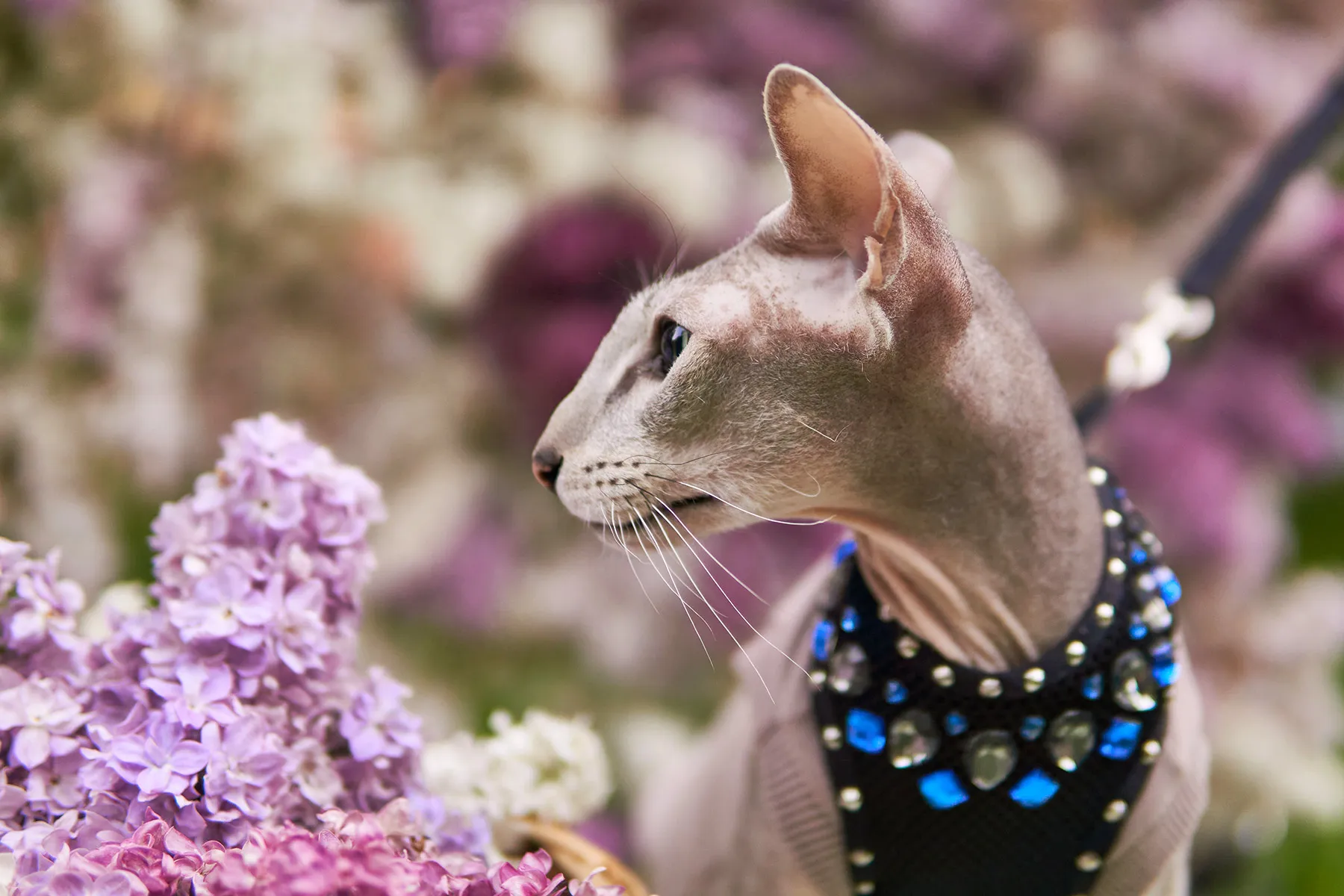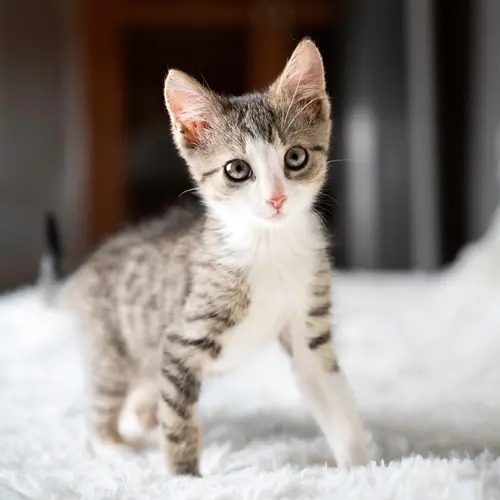
The Peterbald cat breed originated from Russia. It's a medium sized cat breed that’s often completely hairless or can have some variation of a fur coat.
Peterbalds are dainty, intelligent-looking felines that grow very attached to their owners and will insist on accompanying you as you do anything around the house. These cats are extremely affectionate and will be your best friend.
Peterbald Characteristics
While personality traits are quite consistent across the breed, the factor that sets Peterbalds apart from each other is their coats. Breeders aren’t always able to predict exactly what the kittens in each litter will look like.
Sometimes there will be kittens that are totally hairless, kittens with a peach fuzz-like coat, kittens born with a coat that will fall out later in life, or kittens that end up with sparse, coarse hair. Hairless Peterbalds are referred to as having the Peterbald gene. The varying coats among these cats can make completely hairless Peterbalds a rare find.
Some Peterbalds even end up with a fine, short coat like a regular short-haired domestic cat. It all comes down to which dominant genes affect a particular cat. While these cats can be classified as a Peterbald, they often aren’t able to compete in championships.
If they do have hair, they can be bicolor, tabby, solid, or slightly darker in color around the face, feet, and tail (color point). Their eyes are usually green, blue, or golden yellow.
Interestingly, the way the cat’s whiskers look can also be affected by which dominant coat traits the cat has.
Peterbald cats have a very specific look. Their heads are triangular with a blunt jaw, and their ears are oversized and sit a little farther apart than those of other cats.
Their neck is long and slender, and their body is cylindrical, compact, and muscular. The tail is long and very slim.
The Peterbald size is that of a medium cat. They weigh about 14 pounds when fully grown and are about 17 inches long.
These affectionate cats can be your companion for the better part of two decades. The Peterbald lifespan is about 15 years.
Peterbald cats are well known for how they relate to their owners. The Peterbald personality is lively, friendly, vocal, and extremely affectionate.
These cats will become your shadow as you go about your life at home. They love to curl up next to you on the couch and will follow you from room to room. They’ll wait patiently for you to come home and greet you enthusiastically when you walk in the door.
Peterbalds aren’t just a one-person cat. You’ll find it easy for other members of your family to get along with your new friend starting in kittenhood. They get along well with children and other cats and dogs.
These cats are known for their intelligence, ease of training and inquisitive nature. They’re a joy to be around.
Caring for Peterbald Cats
The Peterbald’s lack of coat or reduced coat means there are a few things you should be aware of.
A coat of fur protects cats from weather extremes like cold weather and high heat. Having a short coat means they're more exposed to the elements and can suffer from sunburn and chills more easily than other cats. These cats are best kept indoors.
Cats naturally produce an oil in their skin that is usually distributed through their fur. If a Peterbald is hairless, the oil often ends up staying on the surface of their skin. You might see greasy marks on your furniture or floors from your Peterbald.
Moist skin can also make an ideal environment for yeast to thrive. These cats can get yeast infections on the skin. You can bathe them regularly to keep their skin clean.
Peterbalds have a higher metabolism than cats with a regular coat of fur. This means they’re less likely to become overweight, and they’ll usually have a good appetite.
You should feed your Peterbald a high-protein diet made up of good-quality food. When you take your new cat to the vet for the first time, you can ask your vet to recommend the best type of brand of food for your cat.
Although they don’t have fur, hairless cats can still benefit from flea and tick prevention. These parasites feed on blood, not fur.
Peterbalds are usually purchased from a breeder. Most breeders will administer the kitten’s first vaccinations and deworming medication, but be sure to ask for all documentation. Present the documents to your vet, and they will decide how to continue the cat's treatment.
Cats can receive both standard and optional vaccinations at the vet.
The standard vaccinations are:
- Feline distemper. This is a combo shot that protects against three diseases: feline herpes (feline viral rhinotracheitis), feline distemper (feline panleukopenia), and FeLV (calicivirus plus feline leukemia virus).
- Rabies. Rabies vaccines are required by law in most states. Rabies is a fatal disease.
Some vets also recommend Chlamydia and Bordetella vaccines for cats, but it’s not common, and they aren’t usually mandatory.
The Peterbald cat can also get heartworm. Heartworm can cause serious damage in cats because treatment options are limited. Preventative medication is the best way to manage your cat’s risk of infection with this parasite.
Your Peterbald cat will benefit from regular dental care. You can get a special toothpaste made for cats from your vet or over-the-counter toothpaste from a pet store. Use a small toothbrush or cotton swab to clean your cat’s teeth. Never use toothpaste made for people on your cat, as it could make them sick.
Chew toys can also help keep your cat's teeth clean.
Health Problems to Watch for With Peterbalds
Peterbalds can sometimes be prone to vision problems. Progressive retinal atrophy is a genetic disease that causes affected cats to slowly lose their vision.
That’s because the light-sensitive cells in the eye (retina) slowly decline. This condition can start as early as 18 months of age. A cat with this condition may face complete blindness by the time they reach 3 years of age.
Your cat might be suffering from vision problems if they're bumping into things around the house or they appear confused and disorientated. If you notice these symptoms in your cat, bring them to your vet. You could also visit a specialist, who might be able to give more insight into the condition.
Special Considerations for Peterbald Cats
Peterbald cats make overall great pets for the whole family. They aren’t known to have any issues with other cats or dogs, making them an easy addition to your family home.
They have a good amount of energy and love to play and learn. They do well with kids and encourage interaction with their responses.
Be careful if your children play rough with pets. Their lack of a regular coat of fur can leave them vulnerable to injury. Peterbalds and other hairless cats are more likely to suffer from scratches and superficial injuries than cats with fur.
Your vet might be able to prescribe an antibiotic ointment to have on hand in these cases. These ointments can help keep wounds clean and promote healing.
If you suffer from allergies, a hairless Peterbald cat may offer the perfect solution. They have little to no dander, so you can pet and snuggle them as much as you want without worrying about any allergic reactions.
History of Peterbalds
The Peterbald cat’s ancestry can be traced to 1988 in the city of Rostov on Don in Russia. People became excited about an unusually hairless cat called the Don Sphynx.
Don Sphynx cats made their way into Europe, where it was soon discovered that kittens from the same litter had different coats. The breeders tried to understand how the genetics worked and what kinds of genetic traits parent cats needed in order to breed hairless cats.
There have been many educated guesses about how to produce hairless Peterbald cats, but no official formula has been created. Peterbald cats bred today continue to have a variety of different coats. Genetic researchers are still studying why this happens.
In 1993, a Don Sphynx named Afinguen Myth was bred with a Oriental shorthair cat named Radma Von Jagerhof by felinologist Olga S. Mironova in St. Petersburg, Russia. The first two litters resulted in the first four official Peterbald cats: Mandarin iz Murino, Muscat iz Murino, Nezhenka iz Murino, and Nocturne iz Murino.
Nocturne Iz Murino became the stud of the breed. His genetics are found in every pedigree Peterbald cat today.
In 1997, the Peterbald breed was accepted by The International Cat Association (TICA). The World Cat Federation accepted them in 2003, and in 2009, they were accepted for championship-class competition by TICA.
